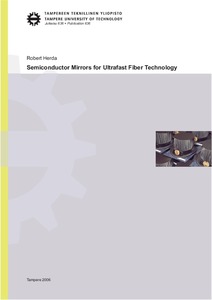Semiconductor Mirrors for Ultrafast Fiber Technology
Herda, Robert (2006)
Herda, Robert
Tampere University of Technology
2006
This publication is copyrighted. You may download, display and print it for Your own personal use. Commercial use is prohibited.
Julkaisun pysyvä osoite on
https://urn.fi/URN:NBN:fi:tty-200810021014
https://urn.fi/URN:NBN:fi:tty-200810021014
Tiivistelmä
This thesis studies the design of Semiconductor Saturable Absorber Mirrors (SESAMs) and their properties in mode-locked fiber lasers. The recovery times of SESAMs were controlled by ion bombardment and metamophoric growth. Quantum-dot structures enabled fast absorber recovery. In resonant saturable absorbers the modulation depth is enhanced, while the saturation fluence is decreased. The strong self-starting mechanism of high-modulation-depth and low-saturation-energy absorbers was used to achieve reliable mode locking without the need for dispersion compensation, while maintaining stability against Q-switched mode locking. It was shown that the two-photon absorption can become the dominant nonlinear mechanism in resonant SESAMs. Two-photon absorbtion in resonant absorbers can improve the stability against Q-switching instabilities; however, excessive two-photon absorption can decrease the modulation depth of a saturable absorber and, therefore, prevent mode locking.
The influence of the SESAM recovery time on the pulse quality was investigated. A fast absorber is preferable in order to avoid instabilities in the pulse shapes and to generate highly compressible pulses. We studied the effect of the recovery time on the self-starting operation of a mode-locked fiber laser. It was shown that amplified spontaneous emission can saturate a slow absorber and, therefore, degrade the modulation depth and prevent self-starting operation. Finally, we demonstrated synchronized operation of a mode-locked µm erbium fiber laser to a mode-locked 1.05 µm ytterbium fiber laser using a semiconductor mirror as an optically driven modulator.
The influence of the SESAM recovery time on the pulse quality was investigated. A fast absorber is preferable in order to avoid instabilities in the pulse shapes and to generate highly compressible pulses. We studied the effect of the recovery time on the self-starting operation of a mode-locked fiber laser. It was shown that amplified spontaneous emission can saturate a slow absorber and, therefore, degrade the modulation depth and prevent self-starting operation. Finally, we demonstrated synchronized operation of a mode-locked µm erbium fiber laser to a mode-locked 1.05 µm ytterbium fiber laser using a semiconductor mirror as an optically driven modulator.
Kokoelmat
- Väitöskirjat [4769]
